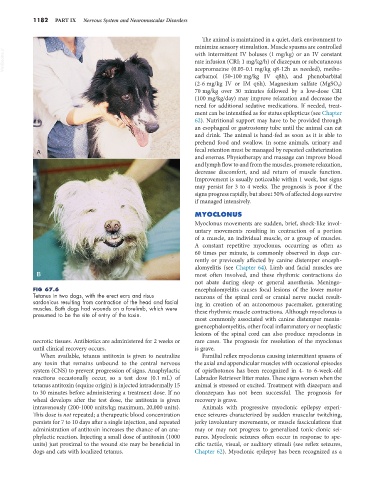Page 1210 - Small Animal Internal Medicine, 6th Edition
P. 1210
1182 PART IX Nervous System and Neuromuscular Disorders
The animal is maintained in a quiet, dark environment to
minimize sensory stimulation. Muscle spasms are controlled
VetBooks.ir with intermittent IV boluses (1 mg/kg) or an IV constant
rate infusion (CRI; 1 mg/kg/h) of diazepam or subcutaneous
acepromazine (0.05-0.1 mg/kg q8-12h as needed), metho-
carbamol (50-100 mg/kg IV q8h), and phenobarbital
(2-6 mg/kg IV or IM q6h). Magnesium sulfate (MgSO 4 )
70 mg/kg over 30 minutes followed by a low-dose CRI
(100 mg/kg/day) may improve relaxation and decrease the
need for additional sedative medications. If needed, treat-
ment can be intensified as for status epilepticus (see Chapter
62). Nutritional support may have to be provided through
an esophageal or gastrostomy tube until the animal can eat
and drink. The animal is hand-fed as soon as it is able to
prehend food and swallow. In some animals, urinary and
A fecal retention must be managed by repeated catheterization
and enemas. Physiotherapy and massage can improve blood
and lymph flow to and from the muscles, promote relaxation,
decrease discomfort, and aid return of muscle function.
Improvement is usually noticeable within 1 week, but signs
may persist for 3 to 4 weeks. The prognosis is poor if the
signs progress rapidly, but about 50% of affected dogs survive
if managed intensively.
MYOCLONUS
Myoclonus movements are sudden, brief, shock-like invol-
untary movements resulting in contraction of a portion
of a muscle, an individual muscle, or a group of muscles.
A constant repetitive myoclonus, occurring as often as
60 times per minute, is commonly observed in dogs cur-
rently or previously affected by canine distemper enceph-
alomyelitis (see Chapter 64). Limb and facial muscles are
B most often involved, and these rhythmic contractions do
not abate during sleep or general anesthesia. Meningo-
FIG 67.6 encephalomyelitis causes focal lesions of the lower motor
Tetanus in two dogs, with the erect ears and risus neurons of the spinal cord or cranial nerve nuclei result-
sardonicus resulting from contraction of the head and facial ing in creation of an autonomous pacemaker, generating
muscles. Both dogs had wounds on a forelimb, which were these rhythmic muscle contractions. Although myoclonus is
presumed to be the site of entry of the toxin.
most commonly associated with canine distemper menin-
goencephalomyelitis, other focal inflammatory or neoplastic
lesions of the spinal cord can also produce myoclonus in
necrotic tissues. Antibiotics are administered for 2 weeks or rare cases. The prognosis for resolution of the myoclonus
until clinical recovery occurs. is grave.
When available, tetanus antitoxin is given to neutralize Familial reflex myoclonus causing intermittent spasms of
any toxin that remains unbound to the central nervous the axial and appendicular muscles with occasional episodes
system (CNS) to prevent progression of signs. Anaphylactic of opisthotonos has been recognized in 4- to 6-week-old
reactions occasionally occur, so a test dose (0.1 mL) of Labrador Retriever litter mates. These signs worsen when the
tetanus antitoxin (equine origin) is injected intradermally 15 animal is stressed or excited. Treatment with diazepam and
to 30 minutes before administering a treatment dose. If no clonazepam has not been successful. The prognosis for
wheal develops after the test dose, the antitoxin is given recovery is grave.
intravenously (200-1000 units/kg; maximum, 20,000 units). Animals with progressive myoclonic epilepsy experi-
This dose is not repeated; a therapeutic blood concentration ence seizures characterized by sudden muscular twitching,
persists for 7 to 10 days after a single injection, and repeated jerky involuntary movements, or muscle fasciculations that
administration of antitoxin increases the chance of an ana- may or may not progress to generalized tonic-clonic sei-
phylactic reaction. Injecting a small dose of antitoxin (1000 zures. Myoclonic seizures often occur in response to spe-
units) just proximal to the wound site may be beneficial in cific tactile, visual, or auditory stimuli (see reflex seizures,
dogs and cats with localized tetanus. Chapter 62). Myoclonic epilepsy has been recognized as a

